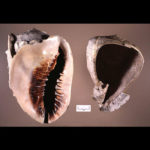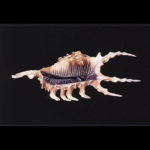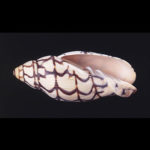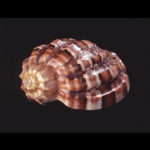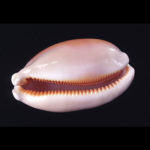Collecting shells has been a pastime of many, young and old, for centuries. It is only when collecting becomes a passion rather than a pastime that the finest examples are sought, and the subject researched in detail.
Such is the case with this collection, one of the country’s finest, assembled by local physician, Peter Stimpson. Focusing on six families of marine gastropods—cowries, cones, conchs, harps, volutes, and olives—the collection includes over one thousand species listed in the Registry of World Record Size Shells. Stimpson has made a portion of his collection available for public enjoyment in this exhibition.Most of the shells on display are those of gastropods, that is, snails. Gastropods form one of the seven classes of the phylum Mollusca. The word “mollusk,” derived from the Latin mollis, meaning “soft,” denotes a large, diverse group of soft-bodied animals who occupy nearly every region of the world. Numbering at least 50,000 living species, mollusks are second in number of species only to the arthropods, which includes insects. Mollusks may live in terrestrial, aquatic, or marine habitats, although marine dwelling mollusks outnumber the others. They may be carnivorous or herbivorous, predator or prey, or often—both.
Most, but not all, mollusks have shells. The two largest classes are the gastropods, which are single-shelled animals, and the bivalves, which have two shells. While the exhibition focuses on gastropods, a few interesting bivalves are also displayed. Examples of mollusks without shells are the octopi and squids.
Shells delight and fascinate us in the visual combination of shape and color. Smooth or textured, symmetrical or not, single-hued or bearing the most complex and astounding patterns of markings, shells treat us to a remarkable display of nature’s art.
Nowhere is the variety of complex patterns more evident than in the family of cones. Bands, zigzags, spots, and dots combine and recombine, not randomly, but according to a plan known to each species.
To even a casual observer, shapes are as distinctive as color. Some reflect the habitat and lifestyle of the animal—a sand burrower needs a smooth, slender, and tapering shell; for life atop a muddy bottom, spines may broaden weight distribution and prevent sinking.
Mathematicians have modeled a shell’s geometry, a closed curve revolving about a fixed axis. Each gastropod species’ genetic code specifies the parameters, which result in the incredible array of shapes, all variations of a logarithmic spiral.
People have used mollusks and their shells for millennia. Mollusks are a major food source still, especially in communities adjacent to the ocean. The beauty of shells appealed also to these inhabitants, and shells were, and are, collected and transformed into ornaments for both personal decoration and embellishment of clothing and other objects. Even in prehistoric times, shells were traded far from their place of origin, often becoming symbols of wealth and status.
- MODERN HELMET SHELL and SHELL CUP, six-hundred-year-old shell cup (right); (left) modern helmet shell
- SCORPIO CONCH, Lambis scorpius (Linné, 1758), Family, Conchs, Strombidae, Philippines
- BEDNALL’S VOLUTE, Volutoconus bednalli (Brazier, 1878), Family, Volutes, Volutidae, Australia
- MAJOR HARP, Harpa major (Röding, 1798), Family, Harps, Harpidae, Philippines
- GOLDEN COWRIE, Cypraea aurantium (Gmelin, 1791), Family, Cowries, Cypraeidae, Philippines
The archaeological shell artifacts in the exhibition, including those pictured below, are from the McClung Museum collections.The shell collection was loaned by Peter Stimpson; the exhibition is sponsored by Eli Lilly and Company, and by Pfizer Pharmaceuticals; and the brochure is sponsored by Pfizer Pharmaceuticals.

